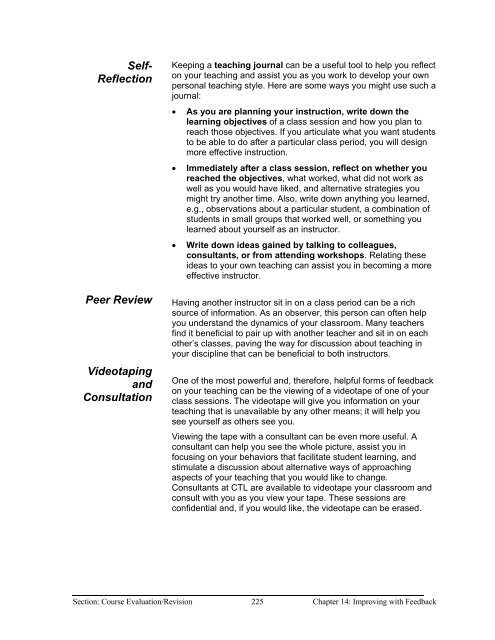Chapter 9 - Instructional Media: Chalkboards to Video - CGISS
Chapter 9 - Instructional Media: Chalkboards to Video - CGISS
Chapter 9 - Instructional Media: Chalkboards to Video - CGISS
Create successful ePaper yourself
Turn your PDF publications into a flip-book with our unique Google optimized e-Paper software.
Self-<br />
Reflection<br />
Peer Review<br />
<strong>Video</strong>taping<br />
and<br />
Consultation<br />
Keeping a teaching journal can be a useful <strong>to</strong>ol <strong>to</strong> help you reflect<br />
on your teaching and assist you as you work <strong>to</strong> develop your own<br />
personal teaching style. Here are some ways you might use such a<br />
journal:<br />
• As you are planning your instruction, write down the<br />
learning objectives of a class session and how you plan <strong>to</strong><br />
reach those objectives. If you articulate what you want students<br />
<strong>to</strong> be able <strong>to</strong> do after a particular class period, you will design<br />
more effective instruction.<br />
• Immediately after a class session, reflect on whether you<br />
reached the objectives, what worked, what did not work as<br />
well as you would have liked, and alternative strategies you<br />
might try another time. Also, write down anything you learned,<br />
e.g., observations about a particular student, a combination of<br />
students in small groups that worked well, or something you<br />
learned about yourself as an instruc<strong>to</strong>r.<br />
• Write down ideas gained by talking <strong>to</strong> colleagues,<br />
consultants, or from attending workshops. Relating these<br />
ideas <strong>to</strong> your own teaching can assist you in becoming a more<br />
effective instruc<strong>to</strong>r.<br />
Having another instruc<strong>to</strong>r sit in on a class period can be a rich<br />
source of information. As an observer, this person can often help<br />
you understand the dynamics of your classroom. Many teachers<br />
find it beneficial <strong>to</strong> pair up with another teacher and sit in on each<br />
other’s classes, paving the way for discussion about teaching in<br />
your discipline that can be beneficial <strong>to</strong> both instruc<strong>to</strong>rs.<br />
One of the most powerful and, therefore, helpful forms of feedback<br />
on your teaching can be the viewing of a videotape of one of your<br />
class sessions. The videotape will give you information on your<br />
teaching that is unavailable by any other means; it will help you<br />
see yourself as others see you.<br />
Viewing the tape with a consultant can be even more useful. A<br />
consultant can help you see the whole picture, assist you in<br />
focusing on your behaviors that facilitate student learning, and<br />
stimulate a discussion about alternative ways of approaching<br />
aspects of your teaching that you would like <strong>to</strong> change.<br />
Consultants at CTL are available <strong>to</strong> videotape your classroom and<br />
consult with you as you view your tape. These sessions are<br />
confidential and, if you would like, the videotape can be erased.<br />
Section: Course Evaluation/Revision 225 <strong>Chapter</strong> 14: Improving with Feedback
















